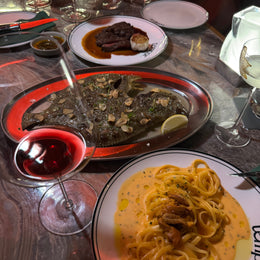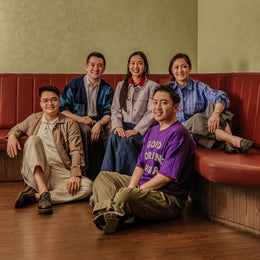
I blink my eyes and struggle to listen. “Uhh so that is the mash tun?” I asked sheepishly, with a malt and alcohol clouded brain. Benjamin, the Head Brewer at Lion Brewery, smiles and patiently repeats his explanation for what is probably the fourth time. “No, this is the mash tun,” he says with his palms on the vat in front of him, “that, is the brewing kettle.” I nod quickly.

I am at Thirty Six Brewlab & Smokehouse, a micro-brewery, beer pub and restaurant concept run by Lion Brewery Co. The restored heritage building houses a 500-litre microbrewery with 23 beer taps pouring a selection of the craft beers made on-site.
The genius that I am had skipped breakfast this morning. And because the tour hasn’t started yet, I couldn’t not do a mid-day sesh on an empty stomach. After downing two refreshing ones (the flagship Island Lager and Straits Pale Ale), it’s getting little difficult to follow what’s being said on the tour. Ben must regret pouring me a pint at the beginning.

Lion Brewery Co has several brewing locations. It operates a microbrewery out of a quaint heritage building along the fashionable 36 Club Street in Singapore. Larger quantities of its core beers are brewed via a “gypsy brewery” in Cambodia called Kingdom Breweries.

I’m visiting Lion Brewery Co.’s microbrewery in Singapore to learn a little more about the craft brewing scene in Singapore. That is, if I’m able to get through this lesson.
So how is craft beer made?
Beer is traditionally made by extracting sugar from a watery mixture of malted barley, flavouring it with hops, then adding yeast to ferment and convert the sugars into alcohol and fizzy carbon dioxide.
Milling. Malted barley is first ground into fine grist.
Mashing. Then, the ground malt is poured into a tank (known as the mash tun) with some warm water, where the mixture is constantly mixed into a wet mash. This process activates the natural enzymes in the mixture, causing it to break down starch into small molecules of sugar.


After the mashing process, the thick mash is then drained and filtered (known as lautering) to extract a sweet syrupy liquid known as wort.

Boiling and wet-hopping. The clear liquid wort is then transferred to a kettle for boiling.

In the kettle, hops are added to the wort and boiled with it. The boiling helps to sterilise and thicken the wort. It also extracts the herbaceous bitter notes from the hops – which we are so familiar with in beers – to balance out the sweetness of the wort. Traditionally, hops were added as a natural preservative to help beers last longer on the shelves. The famous IPA (or India Pale Ale) style of beers tend to be more bitter precisely because English sailors added extra hops to their beer to preserve them for long ocean voyages to British India.
After a couple of hours of boiling, it’s time for vat fermentation.
Fermentation, wet-hopping, flavouring. Finally, the sugary liquid is piped from the kettle to the fermentation vats at the back.

Here is where most of the magic happens. Yeast, these tiny little microbes, would be added to the sugary mixture where they would consume the sugars and produce both alcohol (ethanol) and make the mixture carbonated (carbon dioxide).

Yeasts have different personalities too. Ales are made with “top-fermenting yeast” that prefer warmer temperatures of 20 to 22 °C (68 to 72 °F). Lagers are made with “bottom-fermenting yeast” that prefer cooler temperatures of 7 to 13 °C (45 to 55 °F).
Ben explained that as a craft brewery, they get the luxury to experiment with different levers and switches. What happens if you switch up the yeast strains for instance? The brewery experimented using “top-fermenting yeast” whilst keeping the temperature lower. The result is something resembling German Kölsch beers; a light, crisp hybrid between a lager and an ale.
How long is the fermentation period? Around 2 to 3 weeks. Ben described yeasts as “greedy little creatures.” These creatures would continuously consume the sugars until there is none of it left. “Once they’ve eaten their fill, they are fat, bloated and heavy, and would sink to the bottom of the beer,” Ben explained, “this is known as flocculation”.
“You can’t leave the beer in the fermenter for too long through! If you do, something called autolysis happens and the beer goes bad.” Think of it as these plump yeast cells exploding and releasing unwanted contents and off-flavours into your beer.
Hops are once again added at this stage – a step known as dry-hopping. While hops added earlier (wet-hopping) add bitterness, the hops added late in the brewing process are crucial in infusing the beer with pleasant aromas of fruits, florals or herbs.
Ben took out two bags of hop pellets and offered me a whiff.

The first bag of “Ella hops” had very mild aromas of sour lime, spice and a familiar bitter herbaceous note of IPAs. The second bag of hops on the other hand was incredibly fruity and citrusy with bright notes of grapefruit, lemon and mangos that reminds me of drinking a citrusy and minty mojito. Those were the “Moutueka hops”.
According to Ben, brewers reserve more expensive or unique hop varieties for the dry-hopping stage. The milder Ella hops were used to bitter the beer at the wet-hopping stage (see above). The much fruitier Moutueka hops are used for dry-hopping to give the beer its juicy, fruity notes.

A couple of beers on tap at the Brewlab are fruit forward – the Two to Mango and Raspberry Beret. My favourite – the Melaka Pumpkin Ale – is rich, velvety, full of baking spices and unusual notes of roasted and caramelised pumpkin. These fruit-forward beers were made with the addition of fresh fruits or pureed fruits into the fermentation vat.
We wrapped up the tour with a flight of these 3 fruit-forward brews by the bar counter.


As we retire to behind the bar, I could see that fresh on draught are Lion Brewery Co’s flagship and a line-up of seasonal brews which are constantly rotated. Ben had recently brewed a new experimental batch of beer which he proudly tapped directly from the brewery equipment for a sample.

I sat back in my seat to enjoy the cold ones and the afternoon in a good state buzz.
Lest I forget and get caught up in my alcoholic reveries, this bar off the quiet corner of Club Street calls itself a “smokehouse” with a full-service kitchen that focuses on hearty open flame-grilled dishes.

While I didn’t have the opportunity to have a three-course dinner here, I made a mental note to pop by another time.
Some of the most popular dishes here are the Sticky Pork Ribs – caramelised tender pork loin slow cooked over fire and slathered with flavourful spicy sauce, topped with coriander and finished with a squeeze of lime. The soft boiled Scotch Eggs marry the spice of Italian Nduja salami, finished with an aromatic garlicky heat gives it an Asian twist.

There are also vegetarian options here, such as the Wood Fired Cauliflower with cashew nut butter, miso leek puree and kale, and an Impossible Meat Burger.
And that’s the long and short of how craft beer is brewed in Singapore! Or at least that’s what I managed to take away half-intoxicated in the afternoon.
The Thirty Six Brewlab is now open to public for brewery tours. For a behind-the-scenes look at what it takes to make tasty craft beer in Singapore, book a tour on their site which includes a tour of the Brewlab and a tasting session of up to 6 craft beers from tap.

@CharsiuCharlie
Thirty Six Brewlab & Smokehouse
36 Club Street Singapore 069469
Open daily: Mon - Tue 4pm - 10.30pm Wed - Fri 12pm - 10.30pm Sat - Sun 10am - 10.30pm
Website: www.thirtysix.sg | IG: @thirtysix_sg | FB: @thirtysixSG







